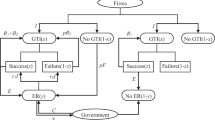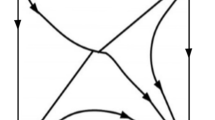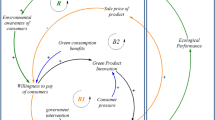Abstract
Green production problem is still an important research content in the field of environment management. This paper analyzes the strategic interaction between the government and the enterprise through building an evolutionary game model. In the built model, the impact of the opportunity income generated by the green production input costs is considered. Also, media supervision is now widely used. Therefore, the probability that the media can discover the enterprise’s non-green production behavior is considered when building the game model. How this probability affects the system is discussed. And advice on how to urge the enterprise to implement green production are proposed according to the effects.
Funding: Social Science Foundation of Beijing (19GLC066).
Access provided by Autonomous University of Puebla. Download conference paper PDF
Similar content being viewed by others
Keywords
1 Introduction
As environmental issues are one of the key concerns of many countries, green production becomes an essential requirement for enterprises. However, because there exists many influencing factors, non-green production behavior still happens. For example, the occurrence of random environmental accidents is an obvious factor [1]. The location of the environmental accidents are always dispersed, which is another obvious factor [2, 3]. Therefore, how to urge the enterprises to implement green production becomes a fundamental problem to be solved now.
There are two stakeholders in the problem of green production management: the government and the enterprise. This interaction between the government and the enterprise is usually described by supervision game. And traditional games are commonly used to study this interaction [4]. In these game models, many factors are considered, including government policies (tax policies and subsidy), consumer behavior, rebound [5]. Some other influencing factors of the supervision game, such as subsidy, cooperative contract between the manufacture and the retailer, and the social welfare of an enterprise’s green production decision, are also analyzed [6,7,8].
The traditional game assumes that all players are completely rational when making decisions, which is unreasonable. In practice, the players should be assumed as bounded rational [9]. In order to solve the problem of the bounded rationality, evolutionary game is proposed and used in many researches. For example, China’s coalmine safety inspection system is extensively analyzed by using an evolutionary game [10,11,12]. As for the problem studied in this paper, carbon taxes, subsidies and some other factors are considered when building the evolutionary game model of green production supervision [13, 14].
Although many factors have been considered in green production supervision game, there are other factors that have not been studied. From the perspective of the enterprise, the factors that have been studied can be defined as external influencing factors (government subsidies, tax policies, consumer behavior, public participation). From the internal point of view of enterprises, some internal factors also affect the strategic interaction between the government and the enterprise. Because of the limited resources of the enterprise, the resources invested in green production can generate production profit when it is invested in production. As the non-green production behavior may not be discovered by the government, opportunistic behavior may be taken by the enterprise. Therefore, the opportunity income generated by the green production cost is considered in this paper. Besides, the probability that non-green production behavior is discovered by the media is also considered. This is because that media supervision has become a widespread way of supervision now. Hence, this paper studies the evolution game of government and enterprise in green production from the perspective of opportunity income and media supervision.
This paper is organized as follows. Section 2 provides the problem description, assumptions, and notations of this paper. Section 3 builds the evolutionary game model of the green production supervision problem. Section 4 provides the analysis of the evolutionary stable strategies of the game. Last, conclusions are presented in Sect. 5.
2 Problem Description, Notations, and Assumptions
2.1 Problem Description
In the game studied in this paper, there are two players: the manufacturing enterprise and the government regulator. The enterprise chooses to implement green production or not. Hence, the strategies of the enterprise are {Green, Not Green}. If all of the resources of the enterprise are invested in production, the profit is \(I\). Assume the green production input cost is \(S_{c}\) and the output coefficient is \(h\) (\(h > 0\)), then these resources can generate production profit \(S_{c}^{h}\) when it is invested into production. Therefore, the enterprise’s profit is \(I - S_{c}^{h}\) when it implements green production. On the other hand, all of the resources are invested into production which makes profit \(I\) when it implements non-green production.
Normally, the government take regulatory measures for the sake of reducing the non-green behavior of the enterprise. The regulatory measures include inspections, fine, policies etc. Consequently, the strategy space of the government is assumed as {Strong supervision, Weak supervision}. The cost of strong supervision is assumed to be \(S_{g}\) and the cost of weak supervision is 0.
Figure 1 shows the relationship between the enterprise and the government in the above game.
2.2 Notations
The notations of the variables and the parameters used in this paper are as follows:
-
\(S_{c}\): green production cost of the enterprise.
-
\(S_{g}\): strong supervision cost of the government.
-
\(f\): discovery probability of non-green production behavior of the enterprise.
-
\(h\): output coefficient of the enterprise’s production.
-
\(I\): the profit generated by all of the resources from the enterprise.
-
\(r_{{\text{c}}}\): rewards for the enterprise. Normally, if the enterprise complies with green production guideline when the government take strong supervision strategy, the enterprise can get some policy or funds support from the government.
-
\(P_{c}\): penalty imposed on the enterprise. Once the non-green production behavior of the enterprise is discovered, the government will impose some penalty, for example, a fine, on the enterprise.
-
\(P_{g}\): loss of the government. If the local government’s nonfeasance is discovered by the media, there will be some loss to local government, including the decline of credibility, the reduction of funds from central government, etc.
-
\(T_{c}\): cost of pollution treatment. Once the pollution brought by the enterprise’s non-green production behavior is discovered by the media, the enterprise has to treat pollution which generates cost \(T_{c}\).
2.3 Assumptions
We propose three assumptions before building the evolutionary game model, which are as follows.
Assumption 1: When the enterprise takes non-green behavior and the government takes weak supervision, the environmental pollution happens. In other cases, green production equipment is installed actively or passively.
As mentioned in Sect. 1, the location of the environmental accidents are always dispersed, this makes the pollution difficult to be found. Consequently, assumption 2 is proposed.
Assumption 2: Environmental pollution is discovered with probability \(f\).
Assumption 3: \(P_{g} > P_{c}\).
Assumption 3 ensures that the government has the incentive to supervise the enterprise.
The goal of the players are all assumed to be profit maximization.
3 Model
According to the above analysis, the payoff matrix of green production supervision game in this paper is given in Table 1.
In practice, the players are all bounded rational. That is to say, they will adjust their decision gradually according to the game results of the previous stage. After analyzing the payoff matrix of the stage game, we built the evolutionary game model for the problem studied in this paper.
Suppose the players were drawn randomly in pairs from two populations and received the expected payoffs noted in Table 1. \(y\) represents the probability that the government takes the pure strategy “Strong Supervision” and \(x\) represents the current proportion of the population of the enterprise taking the pure strategy “Green.” Subsequently, the expected payoffs of the enterprise and the government are denoted as shown in Eq. (1) and Eq. (2), respectively:
where \(A = \left( {\begin{array}{*{20}l} {I - S_{c}^{h} + r_{c} } \hfill & {I - S_{c}^{h} } \hfill \\ {I - S_{c}^{h} - P_{c} } \hfill & {I - f(P_{c} + T_{c} )} \hfill \\ \end{array} } \right)\), and \(B = \left( {\begin{array}{*{20}l} { - S_{g} } \hfill & 0 \hfill \\ {P_{c} - S_{g} } \hfill & {f(P_{c} - P_{g} )} \hfill \\ \end{array} } \right)\).
Then, the standard two-population replicator dynamics model of the green production supervision game can be written as follows:
4 Results and Analysis
Through solving \(\left\{ \begin{gathered} \frac{dx}{{dt}} = 0 \hfill \\ \frac{dy}{{dt}} = 0 \hfill \\ \end{gathered} \right.\), we obtained five local equilibriums of the two-population replicator dynamics model. They are: \((x^{*} ,y^{*} )\), \((0,0)\), \((0,1)\), \((1,0)\) and \((1,1)\). \(x^{*} {\text{and}} \, y^{*}\) are denoted as follows:
Although we have got five equilibriums of the studied problem, local equilibriums may not be the evolutionarily stable strategy (ESS) of the replicator dynamics system. One commonly used method to determine the global equilibrium is the method proposed by Friedman [9]. This method judge whether a local equilibrium is an ESS or not through analyzing the value of the trace and determinant of the Jacobian matrix of the differential equation. The Jacobian matrix of a differential equation \(J\) is as follows:
If the determinant and the trace satisfies the following two conditions, then the corresponding local equilibrium is an ESS.
Condition (1):
Condition (2):
where:
The values of \(a_{11}\), \(a_{12}\), \(a_{21}\), and \(a_{22}\) in each local equilibrium are given in Table 2.
In Table 2, \(A = x^{*} (1 - x^{*} )[S_{c}^{h} + r_{c} + (1 - f)P_{c} - fT_{c} ]\), \(B = y^{*} (1 - y^{*} )[(1 - f)P_{c} + fP_{g} ]\).
It is obvious that the probability that non-green production behavior of the enterprise is discovered by the media affects the ESS of the system significantly. Therefore, the ESS of the system based on the value of \(f\) is given in Proposition 1.
Proposition 1:
(a): If \(0 \le f < \min \{ \frac{{S_{c}^{h} }}{{P_{c} + T_{c} }},\frac{{S_{g} - P_{c} }}{{P_{g} - P_{c} }}\}\), the ESS of the model is (0,0);
(b): If \(\frac{{S_{g} - P_{c} }}{{P_{g} - P_{c} }} < f < \frac{{S_{c}^{h} }}{{P_{c} + T_{c} }}\), the system is in periodical fluctuations.
(c): If \(f > \frac{{S_{c}^{h} }}{{P_{c} + T_{c} }}\), the ESS of the system is (1,0).
To better understand the trends of evolution, a simulation analysis is shown in Fig. 2.
Proposition 1 and Fig. 1 show the ESS of the green production supervision game. When the probability the non-green behavior is discovered by the media is relatively low, which is case (a), the ESS is (0, 0). And when this probability is a little larger, which is case (b), the replication dynamic system shows a fluctuating trend. Under this circumstance, the system has a stable limit cycle, but it was not asymptotically stable [10]. Last, when the probability is large enough, which satisfy the condition in case (c), the ESS is (1, 0). It is assumed that environmental pollution only happens when the government and the enterprise are all negative on green production. Consequently, the state of case (c) is better than that of case (b) and case (b) is better than that of case (a).
Based on the above analysis, how to encourage the media to discover non-green production behavior is an effective way to realize green production. For example, the government can reward with money the media which pays more attention to green production behavior. The government also can improve the credibility of these media to encourage other media focus on green production.
5 Conclusion
Green production is still an important concern of many countries in the world. Because green production relies on the decision of the enterprise itself and the government’s supervision decision, this paper analyzes the strategic interaction between the enterprise’s decision and the government’s decision by building evolutionary game model. In this model, the opportunity income generated by the green production input costs and the probability that non-green production behavior is discovered by the media are considered. Through solving the model, the ESS of the system is given. How the probability discovered by the media affects the system is analyzed. Results show that encouraging the media to report the enterprise’s non-green behavior can help to realize green production.
References
Beavis, B., Walker, M.: Random wastes, imperfect monitoring and environmental quality standards. J. Public Econ. 21(3), 377–387 (1983)
Kim, S.H.: Time to come clean? disclosure and inspection policies for green production. Oper. Res. 63(1), 1–20 (2015)
Wang, S., Sun, P., De Vericourt, F.: Inducing environmental disclosures: a dynamic mechanism design approach. Oper. Res. 64(2), 371–389 (2016)
Schol, J.T.: Cooperative regulatory enforcement and the politics of administrative effectiveness. Am. Polit. Sci. Rev. 85(1), 115–137 (1991)
Soroush, S., Morteza, R.B.: A game theoretic approach for assessing residential energy-efficiency program considering rebound, consumer behavior, and government policies. Appl. Energy 233–234, 44–61 (2019)
Ma, W., Zhang, R., Chai, S.: What drives green innovation? a game theoretic analysis of government subsidy and cooperation contract. Sustainability. 11, 5584 (2019)
Jeong, E.B., Park, G.W., Yoo, S.H.: Incentive mechanism for sustainable improvement in a supply chain. Sustainability 11, 3508 (2019)
Zhang, Z., Wang, Y., Meng, Q., Luan, X.: Impacts of green production decision on social welfare. Sustainability 11, 453 (2019)
Friedman, D.: On economic applications of evolutionary game theory. J. Evol. Econ. 8(1), 15–43 (1998)
Liu, D., Xiao, X., Li, H., Wang, W.: Historical evolution and benefit-cost explanation of periodical fluctuation in coal mine safety supervision: an evolutionary game analysis framework. Eur. J. Oper. Res. 243(3), 974–984 (2015)
Liu, Q., Li, X., Hassall, M.: Evolutionary game analysis and stability control scenarios of coal mine safety inspection system in China based on system dynamics. Saf. Sci. 80, 13–22 (2015)
Liu, Q., Li, X., Meng, X.: Effectiveness research on the multi-player evolutionary game of coal-mine T safety regulation in China based on system dynamics. Saf. Sci. 111, 224–233 (2019)
Chen, W., Hu, Z.H.: Using evolutionary game theory to study governments and manufacturers’ behavioral strategies under various carbon taxes and subsidies. J. Clean. Prod. 201, 123–141 (2018)
Fan, R., Dong, L., Yang, W., Sun, J.: Study on the optimal supervision strategy of government low-carbon subsidy and the corresponding efficiency and stability in the small-world network context. J. Clean. Prod. 168, 536–550 (2017)
Acknowledgment
We thank for the anonymous reviewers, whose advice helps improve the quality of this paper. Also, this study was supported by the Social Science Foundation of Beijing (19GLC066).
Author information
Authors and Affiliations
Corresponding author
Editor information
Editors and Affiliations
Rights and permissions
Copyright information
© 2022 The Author(s), under exclusive license to Springer Nature Singapore Pte Ltd.
About this paper
Cite this paper
Ma, Y., Zheng, Z., Jin, C. (2022). The Evolution Game of Government and Enterprise in Green Production—The Perspective of Opportunity Income and Media Supervision. In: Shi, X., Bohács, G., Ma, Y., Gong, D., Shang, X. (eds) LISS 2021. Lecture Notes in Operations Research. Springer, Singapore. https://doi.org/10.1007/978-981-16-8656-6_4
Download citation
DOI: https://doi.org/10.1007/978-981-16-8656-6_4
Published:
Publisher Name: Springer, Singapore
Print ISBN: 978-981-16-8655-9
Online ISBN: 978-981-16-8656-6
eBook Packages: Business and ManagementBusiness and Management (R0)






